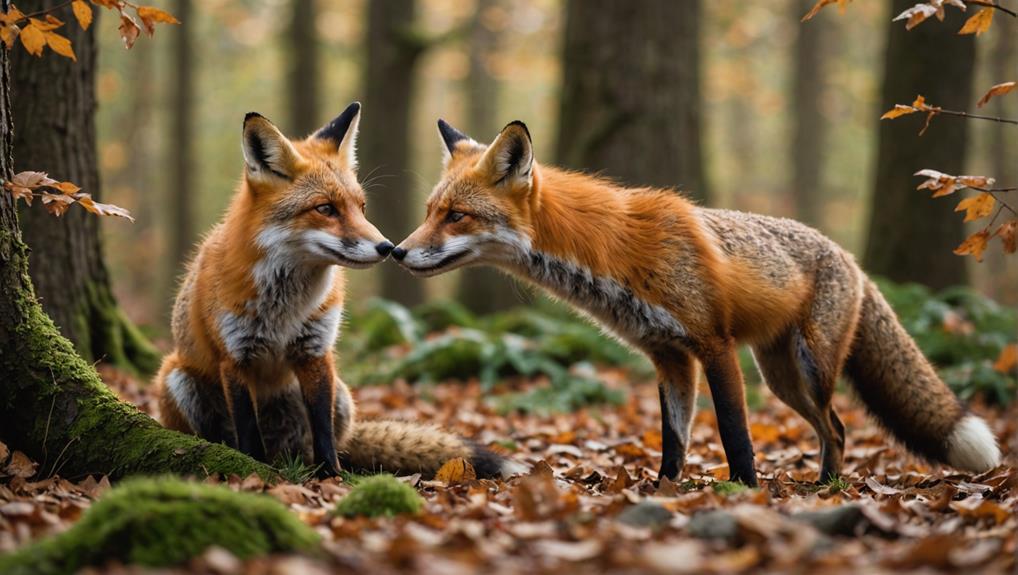As you step into the forest, a rustle in the underbrush catches your attention, and a fox emerges, its bushy tail twitching like a metronome. You're drawn into a world of subtle cues, where a flick of the ear or a tilt of the head conveys a wealth of information about social status, intentions, and relationships. But how do you decipher these signals, and what secrets do they hold about the intricate social dynamics of these cunning creatures? As you observe the fox's behavior, you begin to realize that there's more to their interactions than meets the eye – and you're about to uncover the fascinating language that reveals it all.
Contents
Deciphering Fox Body Language
When you observe a fox's behavior, you're likely to notice that its body language is far more nuanced than you might expect. From tail posture to ear positioning, every movement conveys a message.
For instance, a tail curved in an upside-down U-shape indicates playfulness, while a raised tail suggests readiness for mating. Ears positioned backward and closed eyes typically signal friendliness, whereas erect tails and upright ears denote dominance.
Foxes also use "play bows," lowering their front bodies while keeping their rear raised, to initiate play and form social bonds. An open mouth can signify a greeting or invitation to play, not aggression, as commonly misinterpreted.
Understanding the context of interactions is crucial, as playful encounters may be misread as aggressive behavior. Recognizing subtle body language cues is key to deciphering fox behavior.
As you watch cubs start to interact, you'll notice they begin to develop these cues from an early age. By paying attention to these details, you'll gain a deeper understanding of fox behavior and better appreciate their social nature.
Social Structure and Interactions
Their social structure, a fluid and dynamic entity, revolves around a breeding pair and their offspring, forming a nuclear family unit that challenges traditional canid studies' rigid dominance models.
You'll notice that their social hierarchy is constantly shifting, with dominance established through social interactions and resource management. This flexibility is key to their survival, as it allows them to adapt to changing circumstances.
In urban environments, foxes have demonstrated behavioral flexibility and adaptability, leading to increased exploratory behavior and risk-taking. Their ability to thrive in high-density habitats is also influenced by physical adaptations, such as shorter snouts and larger skulls.
As you observe foxes, you'll see that social bonding is crucial to their well-being. Gentle interactions and grooming behaviors strengthen their bonds, while a lack of contact can lead to social isolation and increased chances of dispersal.
Play fighting among cubs is also essential, as it helps establish social hierarchies and develops necessary interpersonal skills within their family groups.
When conflicts arise, foxes rely on body language and vocalizations to resolve them, with dominant individuals usually avoiding physical confrontations to maintain territorial management and social order.
Communication and Conflict Resolution

As you explore the complex world of fox communication, you'll notice that agonistic displays, like head turning and body shoving, can escalate into intense conflicts.
But foxes also use scent marking to establish clear territorial boundaries, reducing the likelihood of disputes.
Agonistic Displays
Among competitive interactions for food or mating opportunities, aggression among foxes manifests through various agonistic displays, which serve as a crucial means of communication and conflict resolution. These displays can take many forms, such as head turning, body shoving, and biting, and are often seen during competitive interactions.
As you observe fox behavior, you'll notice that dominant individuals typically exhibit erect tails and upright ears, signaling their status, while submissive ones display lowered heads and flat ears as a form of deference.
Vocalizations, like "gekking," also play a key role in communication during conflicts, indicating heightened aggression or the need to assert dominance. Territorial disputes, particularly among vixens, often involve intrasexual aggression, with displays of physical posturing meant to establish hierarchy without escalating to combat.
Foxes use body language, such as tail posture and ear positioning, to convey emotions and intentions, with raised tails often indicating readiness for mating and backward ears suggesting defensiveness.
Territorial Boundary Marking
Boundary definition is a vital aspect of fox social dynamics, and scent marking is a crucial tool in this process. When you observe foxes, you'll notice they utilize scent marking through urination and defecation to establish territorial boundaries, communicating "This is my area" to both potential mates and competitors.
This act serves multiple purposes, including individual identity establishment, attraction to mates, and warning off rivals, ensuring clear communication about resource ownership.
As you watch foxes mark their territory, pay attention to their body language. A raised tail or specific ear positions can further signal their intentions.
Dominant individuals often assert their presence through aggressive displays, which can be intimidating to other foxes. Territorial disputes can provoke aggression, particularly when food scarcity or intruders threaten resource access, leading to confrontations among cubs and adults alike.
Effective conflict resolution among foxes often involves utilizing visual communication to avoid physical confrontations and maintain social order within a territory. By understanding these cues, you can better appreciate the complex social dynamics at play in the world of foxes.
Contextual Vocal Cues
You've observed how foxes use scent marking to establish territorial boundaries, but now it's time to explore how they communicate through vocal cues. Foxes have a remarkable range of vocalizations – 28, to be exact – which vary in meaning and context.
From bark-like sounds to softer vocalizations for intimate communication between mates, the tone, intensity, and context of these cues affect their meaning.
Aggressive vocalizations, like "gekking," indicate heightened aggression, often during territorial disputes or conflicts with other foxes. However, vocal cues also play a crucial role in conflict resolution.
Foxes may rely on sound and body language to establish dominance and avoid physical confrontations. By combining vocalizations with body language, like a raised back or assertive posture, foxes can signal their intentions and resolve disputes without resorting to violence.
This adaptability in communication methods is remarkable, and observations have shown that vocalizations can vary by region and social group, reflecting the unique social bonds within each group.
Territorial Behavior and Resource Management
Frequently, dominant fox pairs take center stage in managing their territory, utilizing aggressive displays and scent marking to signify ownership and deter intruders. You might witness them standing tall, ears perked, and fur fluffed up, broadcasting their dominance to potential competitors. This territorial behavior is crucial, as it dictates access to vital resources like food, shelter, and breeding opportunities.
Intrasexual aggression, particularly among vixens, is common during territorial disputes, highlighting the competitive nature of resource management within fox communities. For instance, as seen in the case of the Arctic fox's adaptability(https://www.illchansethislater.com), their ability to thrive in diverse habitats and ecosystems affects their social interactions and resource management.
Similarly, the Fennec fox's nocturnal lifestyle influences their caching behavior and access to resources. As you observe these interactions, you'll notice that resource availability significantly influences social interactions, even triggering confrontations among cubs as they establish and negotiate their hierarchy.
Sensory Abilities and Hunting Strategies

As you delve into the realm of fox behavior, it becomes clear that their exceptional sensory abilities play a pivotal role in their hunting prowess. Their acute hearing allows them to detect high-frequency sounds, while their sense of smell is so refined it aids in locating prey and mates.
Their vision is adapted for low-light conditions, making them effective hunters during dusk and dawn. Additionally, their keen senses of smell and hearing are crucial for detecting food hidden beneath snow Arctic fox adaptations, and their round body shape helps reduce exposure to the cold, conserving body heat.
When it comes to hunting strategies, foxes are masters of stealth and patience. They utilize stalking techniques to approach prey silently, often relying on cover for concealment.
Their movement patterns are varied, alternating between solo hunting and resting to gather energy for their next patrol. This adaptability is key to their success, as they've learned to adjust their tactics based on the awareness of their prey.
Some key takeaways about fox sensory abilities and hunting strategies include:
- Exceptional sense of smell for prey detection
- Acute hearing for detecting high-frequency sounds
- Adapted vision for enhanced night vision
- Stealthy movement patterns for silent approach
- Alternating hunting tactics based on prey awareness
Fox Behavior Insights and Applications
Beyond their impressive hunting abilities, foxes also exhibit fascinating social behaviors that offer valuable insights into their complex personalities.
By studying their body language, you can gain a deeper understanding of their social dynamics and even learn valuable lessons for your own life. For instance, foxes express playfulness through cues like a tail held in an upside-down U-shape, open mouths, and play bows, which can invite interactions and signify non-aggressive intentions.
On the other hand, aggressive encounters often involve rigid body postures, flattened ears, and vocalizations like "gekking," indicating heightened aggression.
Frequently Asked Questions
How to Tell a Fox's Emotions?
You can decode a fox's emotions by observing its vocal communication, tail position, ear movements, and facial expressions, as a relaxed fox will have a U-shaped tail, floppy ears, and an open mouth, while a dominant one will have an upright tail and ears.
How to Read Fox Body Language?
"Break a leg" understanding fox body language! You're on the right track by analyzing fox posture signals, tail communication cues like the upside-down U-shape, ear position meanings, facial expression interpretation, play behavior analysis, and territory marking signs to decode their emotions and social behavior.
What Is the Social Behavior of the Red Fox?
You'll discover that red foxes thrive in a cooperative fox social structure, where they use body language for effective red fox communication, maintain fox territorial behavior, and engage in mating rituals, all while prioritizing family dynamics and even practicing food sharing.
What Does It Mean When a Fox Approaches You?
As you encounter a fox, it's essential to decipher the intention behind its approach. Are you being sized up for a friendly approach or a cautious stance? Perhaps it's curious exploration, signaling intent for playful interaction, or adopting a defensive posture.
Final Thoughts
As you've delved into the world of fox body language, you've likely been struck by the contrast between their cunning nature and their playful, social sides. On one hand, they're masters of stealth and adaptation, thriving in harsh environments. On the other, they're charismatic creatures that thrive on connection and community. By deciphering their intricate language, you've gained a deeper appreciation for these enigmatic animals, and perhaps, a newfound respect for the complex social dynamics that govern their fascinating world.














